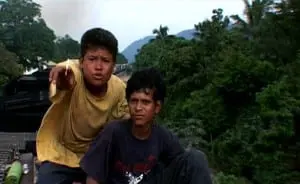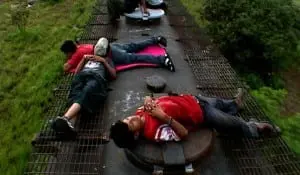Unaccompanied child migrants who try to cross the U.S.-Mexico border
By James O’Barr
“Poor Mexico, so far from God and so close to the United States.” So said Porfirio Diaz in the 19th century, and so it is today. The tortured history of the two countries and the long border they share is not the subject, but the necessary subtext of Rebecca Cammisa’s absolutely remarkable, multi-award-winning documentary, Which Way Home.
 Screening at the Philipstown Depot Theatre on Friday, Jan. 11, the scheduling is strangely apposite, coming as it does almost a month after the killings of the children of Newtown. The film records the perilous efforts of unaccompanied child migrants from Mexico and Central America to get to the United States.
Screening at the Philipstown Depot Theatre on Friday, Jan. 11, the scheduling is strangely apposite, coming as it does almost a month after the killings of the children of Newtown. The film records the perilous efforts of unaccompanied child migrants from Mexico and Central America to get to the United States.
With our eyes fixed on the horror so close to home, and our attention focused, at least for a few minutes, on the awful questions it asks of us as a people and as a culture, it would be forgivable, for once, to look away from the destitution, hunger, violence and hopelessness that characterize the lives of the far-too-many children in the world less privileged than our own. But Which Way Home is cinema at its most verité; it tells the truth and does not let us look away.
Of the many hundreds of thousands of people from all over Latin America who, despite the incredible dangers of the journey, annually take their chances on making it across the U.S.-Mexico border for work to support their families at home, or to find relatives, or to find a better, more secure life in the United States, it is estimated that 5 percent are unaccompanied children.
The kids Cammisa and her intrepid crew (including cinematographers Eric Goethals and Lorenzo Hagerman, production manager Alejandra Liceaga and field producer Sascha Weiss) focus on and follow over the 1,400 miles from the Guatemala-Mexico border to the border with the U.S., come from Honduras, Guatemala and Mexico.
 Among the riskiest of the risks they take along the way is hitching rides on the freight trains, known to them collectively as “The Beast,” that ply those routes. Jumping on and off the moving trains, riding on top of or in boxcars or clinging to the sides, the kids treat the trains like playgrounds rather than the killing machines they can become at any moment.
Among the riskiest of the risks they take along the way is hitching rides on the freight trains, known to them collectively as “The Beast,” that ply those routes. Jumping on and off the moving trains, riding on top of or in boxcars or clinging to the sides, the kids treat the trains like playgrounds rather than the killing machines they can become at any moment.
To vividly illustrate that death is an all-too-possible outcome that the migrants must face, the filmmakers give some attention to the loss of life along the way, not only on the trains, but at the hands of criminals or the smugglers who are paid to take them across or the police, or in the attempt to swim the Rio Grande or to survive the treacherous deserts on both sides of the border.
Perhaps this all sounds too dark, and it would be if the filmmakers hadn’t taken the time to cultivate relationships with several of the children and their families, tell their remarkable stories, and follow the various arcs that their lives and journeys take over time. First amongst equals is Kevin, 14, from a small village in Honduras, traveling with his friend, 13-year-old Frito. They eventually team up with two Mexican teens, Jairo and Yurico, who’s spent 15 of his 17 years living on the streets.
The high spirits, determination, courage, fearlessness, generosity, devotion to their families and determination to help them, and the combination of innocence and street smarts they display in the face of the most daunting, dangerous and unforgiving circumstances, provide a cast of characters that we can sympathize with, pull for, and finally care about. When that happens, the distance between Newtown and Nuevo Loredo, you may notice, will be shortened exponentially.
Which Way Home will be shown at the Philipstown Depot Theatre, Garrison’s Landing, at 7:30 p.m. Special guest Rebecca Cammisa, the film’s director/producer, will be present for a Q-and-A and a reception after the screening. For tickets or to make a reservation, call the theater at 845-424-3900 or go to philipstowndepottheatre.org.

